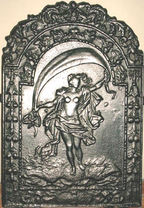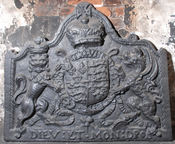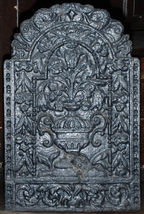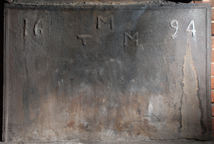-
936
Description: Arched rectangular central panel with triple bead and pellet edging; semi-naked figure of Fortune, holding in her hands a billowing sheet, and standing on a ground; arched rectangular fillet border enclosing suspended swagged flowers and berries (top and sides), with indeterminate foliage on the bottom on either side of an empty cartouche; on top, symmetrical wsirled foliage.
Notes: The design is derived from an engraving by Aegidius Sadeler after a painting by Christoph Schwarz of about 1580-1600. Although not marked as such, other castings of this fireback are marked with the initials, GK, and dated to 1700.
Copies of this fireback are known.
- Decoration tags:
- 'Dutch' (shape)
- fillet (edging)
- whole carved pattern
- pictorial
- allegorical
- humans
Manufactured: in the early 18th century possibly in the Siegerland area of Germany.
Current location: in private hands Haringhuizen, Netherlands.
Citation: Elling, W. & Winkler-Borck, S., 1992, Ofen- und Kaminplatten (Vreden, Hamaland-Museum).
- Attached to series:
- 'Dutch' GK series
-
89
Description: Quasi-arched rectangular shaped, with sides leaning slightly towards the top; wide ovolo edging (top and sides) with twisted rope relief; Tudor shield, garter, crown and supporters (crowned lion and dragon); motto along base; irregular ribbon behind.
Notes: Whole pattern; strong stylistic similarities with a Buckhurst arms fireback (no. 491), an example of which is at Michelham Priory, near Hailsham, East Sussex, suggest a common pattern maker and possibly furnace.
Inscription: DIEV ET MON DROI
Arms: Tudor royal (prob. Elizabeth I)
- Decoration tags:
- quasi-arched rectangular (shape)
- ovolo, simulated rope (edging)
- whole carved pattern
- armorial
- royal
- text
Manufactured: in the late 16th century in the Weald area of England.
Current location: Hampton Court, Richmond, Greater London, England.
Museum number: 1241 (part of the Royal Collection museum group)
- Attached to series:
- Ornate border series
- Tudor royal armorial firebacks
-
168
Description: Quasi-arched shape; straight fillet edging to sides and bottom, symmetrical, stepped cavetto, ovolo, cavetto and double arched on top; central pictorial scene of a female and male seated on a couch, both in 18th century dress, with swirled floral border; swirled floral base panel separated by a fillet; two sea serpents on top.
Notes: The dress of the figures portrayed suggests a late-18th century date
- Decoration tags:
- quasi-arched (shape)
- fillet (edging)
- whole carved pattern
- pictorial
- humans
- objects
Manufactured: in the late 18th century in England.
Current location: Hastings Museum and Art Gallery, John's Place, Bohemia Road, Hastings, East Sussex, England.
Museum number: HASMG: 1910.36 (part of the Hastings Museum museum group)
- Attached to series:
- Miscellaneous pattern firebacks
-
383
Description: Arched rectangular shape; thin twisted rope edging on top and sides; trailing vine strips frame a row of repeated bird (probably swan) stamps (5) above repeated rose en soleil stamps (5); single bird stamp with two short, slanting vine strips in top arch.
Notes: The rose-en-soleil was the badge of King Edward IV and, thus, a Yorkist symbol, while the swan had been adopted by Henry IV and was, therefore, a Lancastrian symbol.
- Decoration tags:
- arched rectangular (shape)
- rope (edging)
- simple stamps
- carved stamps
- heraldic
- objects
Manufactured: in the mid to late 16th century possibly at Pounsley Furnace, Framfield in the Weald area of England.
Current location: Anne of Cleves House, Southover High Street, Lewes, East Sussex, England.
Museum number: LH000.941 (part of the Sussex Archaeological Society museum group)
Citation: Butterfield, W. R., 1916, 'Old Wealden Firebacks', The Connoisseur, 46, pp. 197-209.
-
462
Description: Rectangular with an arched rectangular style arch linked by symmetrical concave curves; ovolo moulding (top and sides); shield, helmet, crest and mantling of the family of Baker, of Mayfield, quartered with Farnden, of Sedlescombe: Quarterly, 1st and 4th, Argent, a tower between three keys erect sable (Baker); 2nd and 3rd, Purpure, a chevron vairy Or and gules, between three leopards’ faces Or (Farnden); crest (Baker): on a tower sable an arm embowed in mail holding in the hand a flint-stone proper. Date split by mantling.
Notes: A carved armorial on a plain, edged base board. John Baker (1644-1723) married Ruth, daughter and co-heiress of Peter Farnden, in 1663; she died in 1691. During their marriage the Farnden arms, would have been borne as an escutcheon of pretence in the centre of the arms of Baker, and not quartered with those of her husband until after her death. The date, 1690, is therefore spurious and would have been added to a later casting of what on other examples is an undated armorial fireback. The same base board has been also used for another achievement of arms dated to the 1740s.
Inscription: 16 90
Arms: Baker of Mayfield quartering Farnden of Sedlescombe
- Decoration tags:
- cavetto-canted arched rectangular (shape)
- ovolo (edging)
- carved pattern panels
- individual numbers
- armorial
- text
Manufactured: in the mid 18th century possibly at Heathfield Furnace in the Weald area of England.
Current location: Barbican House, High Street, Lewes, East Sussex, England.
(part of the Sussex Archaeological Society museum group)
- Attached to series:
- Ironmasters armorial series
- Personal armorial firebacks
-
654
Description: Arched rectangular central panel with bead-and-pellet edging; S-scroll, two-handled, gadrooned vase with tulip stems, flowers and leaves; arched rectangular border with fillet edging and suspended flower bunches; along a rectangular bottom panel with fillet edging a symmetrical arrangement of swirled foliage; on top, two symmetrical, coiled serpents; narrow, curved shouldered side panels with beads in oval depressions.
Notes: The presence of tulips suggest a Dutch origin for the pattern of this fireback, although the presence of several examples in England suggest that it was produced here rather than on the Continent.
Copies of this fireback are known.
- Decoration tags:
- 'Dutch' (shape)
- fillet (edging)
- whole carved pattern
- extension panels
- pictorial
- plants
- objects
Manufactured: in the mid 17th century in England.
Current location: Eastgate House, High Street, Rochester, Kent, England.
Museum number: A3507 (part of the Rochester Guildhall Museum museum group)
- Attached to series:
- Flower Vase 'Dutch' types
- British 'Dutch' style firebacks
-
991
Description: Rectangular with fillet edging (top and sides) formed from separate strips, possible from furniture; date split by letters in triad; number '1' has a central knob.
Notes: The initials are believed to relate to Thomas and Mary Manser, who occupied the Star Inn, Waldron, East Sussex, in the seventeenth century.
Inscription: 16 TMM 94
- Decoration tags:
- rectangular (shape)
- fillet (edging)
- simple stamps
- carved stamps
- text
Manufactured: in 1694 in the Weald area of England.
Current location: The Star Inn, Waldron, East Sussex, England.
- Attached to series:
- Date & initials firebacks
-
1041
Description: Rectangular; twisted rope edging (top and upper three-quarters of sides); central Tudor shield, garter, crown and supporters (greyhound and lion), formed from separate stamps; date on a single stamp in top left corner.
Notes: This is an early example of a fireback being used as a pattern, with the addition of a subsequent date. The same stamps forming the arms can also be seen on other firebacks. The extension of the lower part of the ‘3’ on the date stamp suggests that the numbers may have been fixed to the backing block, rather than the date being carved as a whole. Another variant of this fireback has the rope edging extending further down the sides.
Inscription: 1583 / HONE SOVT qVEY MAL Y PENSE
Arms: Tudor royal (prob. Henry VIII)
- Decoration tags:
- rectangular (shape)
- rope (edging)
- carved stamps
- date stamp
- armorial
- royal
- text
Manufactured: in 1583 in the Weald area of England.
Current location: in private hands, West Hoathly, West Sussex, England.
- Attached to series:
- Pounsley series
- Tudor royal armorial firebacks
- Tudor redated series







